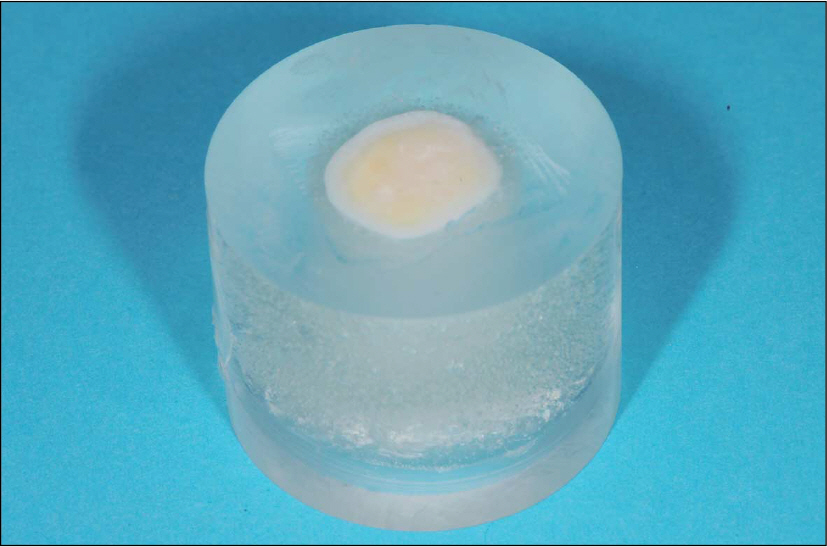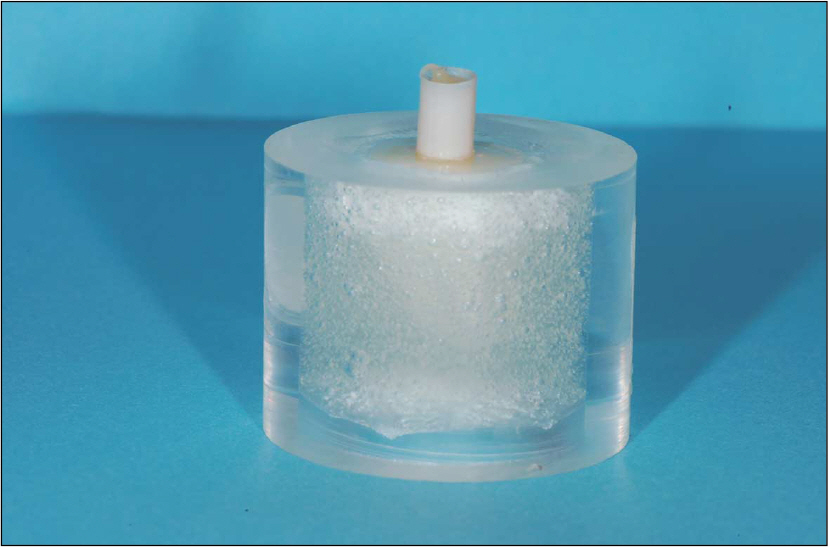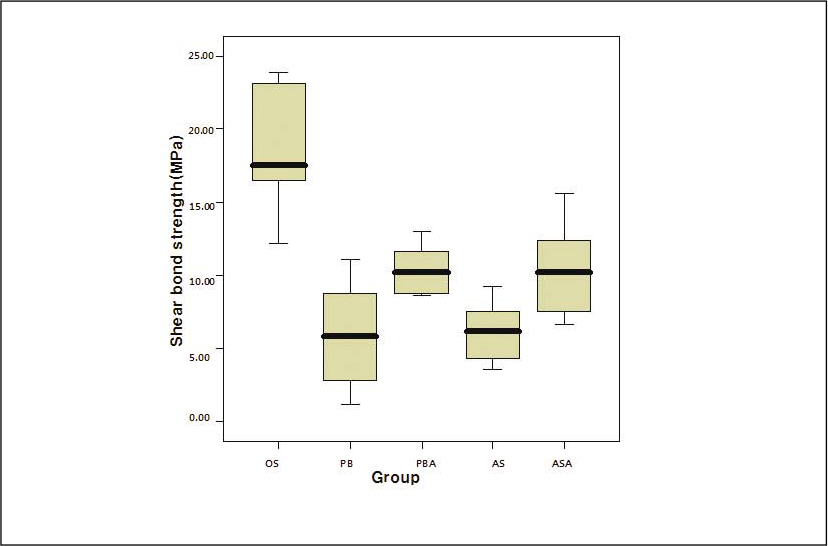J Korean Acad Prosthodont.
2008 Oct;46(5):511-519. 10.4047/jkap.2008.46.5.511.
Effects of activators contained in adhesives on dentin bond strengths
- Affiliations
-
- 1Restorative Dentistry, Korea University Medical Center, Korea.
- 2Department of Esthetic Restorative Dentistry, Korea Universitry, Graduate School of Clinical, Korea. koprosth@unitel.co.kr
- KMID: 2000408
- DOI: http://doi.org/10.4047/jkap.2008.46.5.511
Abstract
- STATEMENT OF PROBLEM: An incompatibility between the initiator systems of self-curing composite resins and light-curing adhesives was supposed recently. PURPOSE: The purpose of the study was to evaluate the influence of activators for self/dual bonding on dentin shear bonding strengths. MATERIAL AND METHODS: Fifty human molars were divided into 5 groups. A flat dentin surface was created for each tooth. A self-curing composite resin (Luxacore) was bonded with the following adhesives (n = 10): One-Step, Prime and Bond NT, AdheSE, Prime and Bond NT and AdheSe were also used in combination with activators. Shear bond strengths were measured after 24 hours of water storage. The specimens were loaded in shear in the Instron until failure at a 1 mm/min crosshead speed. Data were compared using one-way ANOVA and Tukey HSD test (alpha = 0.05). RESULTS: The dentin adhesive systems in order of decreasing median bond strength were One-Step > Prime & Bond NT with activator, AdheSe with activator > Prime and Bond NT, AdheSe. Among adhesives, One-Step had the highest bond strength. Prime & Bond NT with activator had higher bond strengths than Prime and Bond NT that was used alone, and so was AdheSe. CONCLUSION: Shear bond strengths were increased in Prime and Bond NT and AdheSe when these were used with activators comparing used without activators. But using activators was not effective clinically comparing One-Step.
MeSH Terms
Figure
Reference
-
1.Cohen S., Hargreaves KM. Pathway of the pulp. 9th edition.Mosby;2006. p. 807–11.2.Cohen BI., Paqnillo MK., Condos S., Deutsch AS. Four different core materials measured for fracture strength in combination with five different designs of endodontic posts. J Prosthet Dent. 1996. 76:487–95.
Article3.O' keefe KL., Powers JM. Adhesion of resin composite core materials to dentin. Int J Prosthodont. 2001. 14:451–6.4.Castellon P., Burgess JO. Shear bond strength of four core materials to dentin bonded with light-cured or dual-cured adhesive. Am J Dent. 2004. 17:401–3.5.Bolhuis PB., de Gee AJ., Kleverlaan CJ., El Zohairy AA., Feilzer AJ. Contraction stress and bond strength to dentin for compatible and incompatible combinations of bonding systems and chemical and light-cured core buildup resin composites. Dent Mater. 2006. 22:223–33.6.Oliveira SS., Pugach MK., Hilton JF., Watanabe LG., Marshall SJ., Marshall GW Jr. The influence of the dentin smear layer on adhesion: a self-etching primer vs. a total-etch system. Dent Mater. 2003. 19:758–67.
Article7.Hagge MS., Lindemuth JS. Shear bond strength of an autopolymerizing core buildup composite bonded to dentin 9 dentin adhesive systems. J Prosthet Dent. 2001. 86:620–3.8.Sanares AM., Itthagarun A., King NM., Tay FR., Pashley DH. Adverse surface interactions between one-bottle light-cured adhesives and chemical-cured composites. Dent Mater. 2001. 17:542–56.
Article9.Moll K., Schuster B., Haller B. Dentin bonding of light-and self-curing resin composites using simplified total-and self-etch adhesives. Quintessence Int. 2007. 38:27–35.10.Tay FR., Pashley DH., Yiu CK., Sanares AM., Wei SH. Factors contributing to the incompatibility between simplified-step adhesives and chemically-cured or dual-cured composites. PartⅠ. Single-step self-etching adhesive. J Adhes Dent. 2003. 5:27–40.11.Oooka S., Miyazaki M., Rikut A., Moore BK. Influence of polymerization mode of dual-polymerized resin direct core foundation systems on bond strengths or bovine dentin. J Prosthet Dent. 2004. 92:239–44.12.Franco EB., Lopes LG., D' alpino PH., Pereira JC., Mondelli RF., Navarro MF. Evaluation of compatibility between different types of adhesives and dual-cured resin cement. Adhes Dent. 2002. 4:271–5.13.Tay FR., Pashley DH., Suh BI., Carvalho RM., Itthagarun A. Single-step adhesives are permeable membranes. J Dent. 2002. 30:371–82.
Article14.Cheong C., King NM., Pashley DH., Ferrari M., Toledano M., Tay FR. Incompatibility of self-etch adhesives with chemical/dual-cured composites: two-step vs one-step systems. Oper Dent. 2003. 28:747–55.15.Tay FR., Suh BI., Pashley DH., Prati C., Chuang SF., Li F. Factors contributing to the incompatibility between simplified-step adhesives and self-cured or dual-cured composites. PartⅡ. Single-bottle, total-etch adhesive. J Adhes Dent. 2003. 5:91–105.16.Suh BI., Feng L., Pashley DH., Tay FR. Factors contributing to the incompatibility between simplified-step adhesives and chemically-cured or dual-cured composites. PartⅢ. Effect of acidic resin monomers. J Adhes Dent. 2003. 5:267–82.17.Tay FR., Pashley DH., Peters MC. Adhesive permeability affects composite coupling to dentin treated with a self-etch adhesive. Oper Dent. 2003. 28:610–21.18.Munksgaard EC., Irie M., Asmussen E. Dentin-polymer bond promoted by Gluma and various resins. J Dent Res. 1985. 64:1409–11.
Article19.Swift EJ Jr., Perdigão J., Combe EC., Simpson CH 3rd., Nunes MF. Effects of restorative and adhesive curing methods on dentin bond strengths. Am J Dent. 2001. 14:137–40.20.Asmussen E., Peutzfeldt A. Bonding of dual-curing resin cements to dentin. J Adhes Dent. 2006. 8:299–304.
- Full Text Links
- Actions
-
Cited
- CITED
-
- Close
- Share
- Similar articles
-
- Relationship between laboratory bond strengths and clinical performance of dentin adhesives
- The effect of cyanate methacrylate on the shear bond strengths to dentin
- Effects of endodontic tri-antibiotic paste on bond strengths of dentin adhesives to coronal dentin
- A study on the compatibility between one-bottle dentin adhesives and composite resins using micro-shear bond strength
- The effect of repeated bonding on the shear bond strength of different resin cements to enamel and dentin




